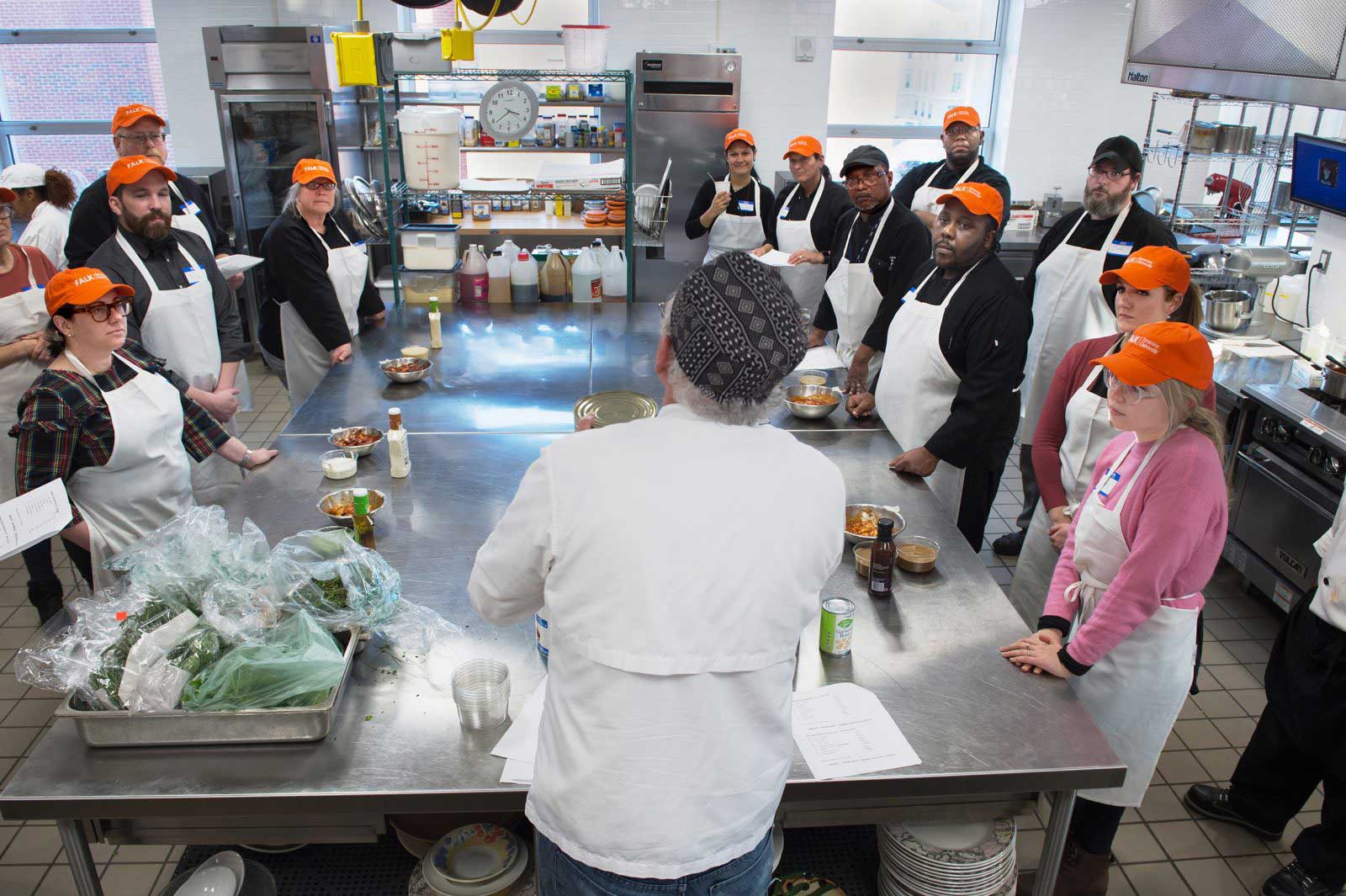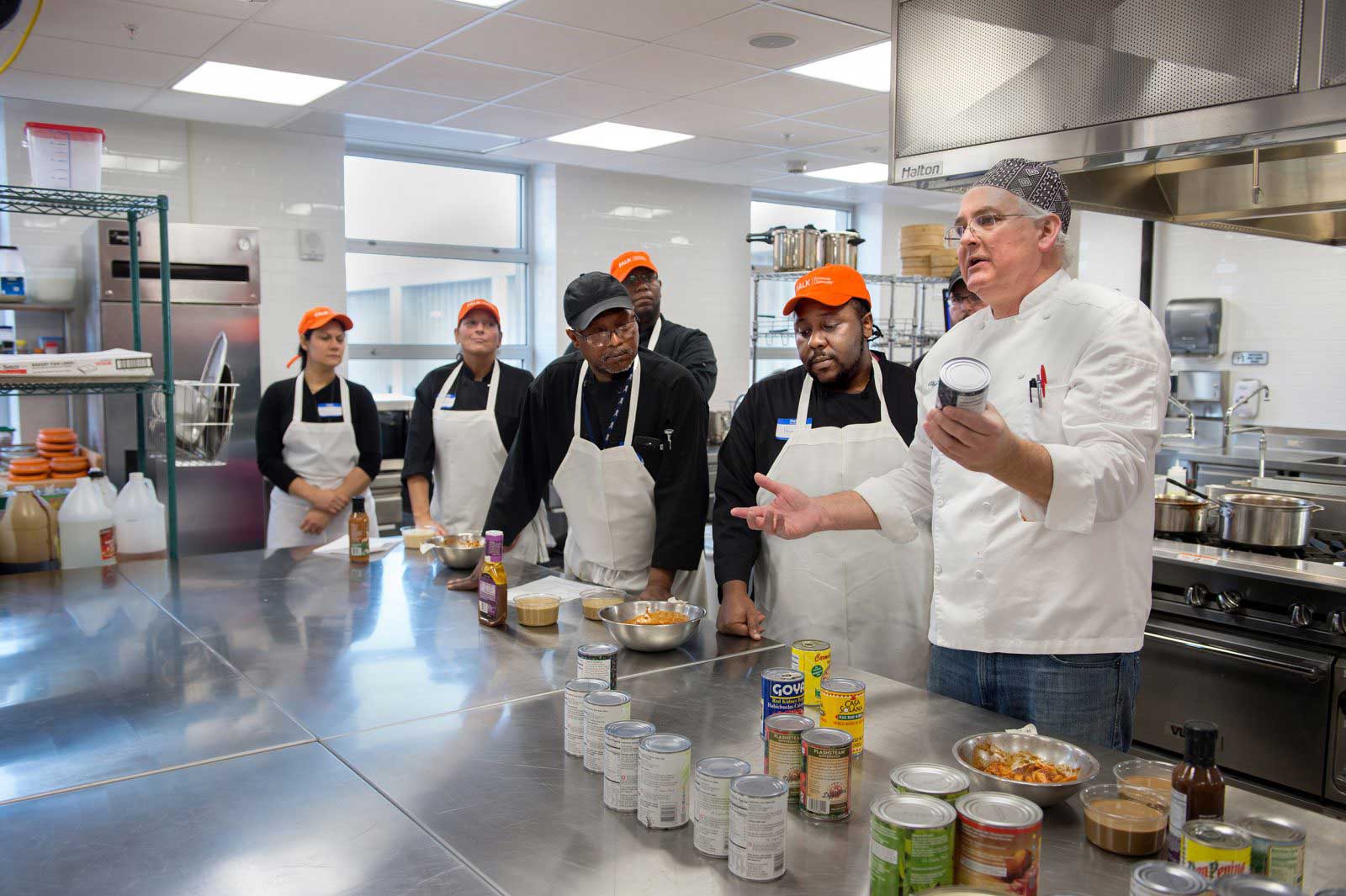
The prevalence of high blood pressure can be attributed to excess salt in the diets of Americans, beginning with what children eat in school, says chef William Collins, a culinary specialist with the Department of Nutrition and Food Studies in Syracuse University’s Falk College. Collins has worked as an executive chef for 25 years and has taught introduction to culinary arts at Falk for the past 12 years.
Today, the average American consumes an estimated 3,400 milligrams of sodium each day, more than one and a half times the recommended limit. Collins recently worked with the Onondaga County Health Department to host a workshop for a cross section of food service staff at schools and colleges in the county. The workshop (which took place before social distancing began) offered recipes, hands-on instruction and seminars for reducing the use of salt in meals served to children and young adults. “I’m a believer that our palates are somewhat trained, even at a young age, to eat what we’re accustomed to,” Collins says. “And if we’re used to having an abundance of salt in our food, that’s the way we’re going to eat for the rest of our lives.”
We reached out to Collins to ask how people can help limit their intake of salt while still producing delicious meals.
Why would you add salt to a dish?
There are two main flavor enhancers in the culinary world. One is salt, and the other is acid. I don’t ever want something to taste salty, and I don’t ever want something to taste sour. But the addition of either of those things to a dish can perk up the flavors that are already there.
Are cooks the source of the overabundance of sodium in the typical American diet?
It really isn’t what we’re putting in our food—it is what the manufacturers are putting in it. That’s where most of our sodium comes from: prepackaged foods and the manufacturing process. For example, look at canned tomatoes or diced tomatoes in water. The sodium content is excessive. Products that are labeled as “no salt added” contain one-tenth of the sodium.
What strategy can a home cook can use to reduce the sodium in a dish?
The addition method is when you add things that are lower in sodium to offset the sodium. For example, if you had a recipe for a marinara sauce that called for two cans of tomatoes, but instead you add some fresh tomatoes. You don’t have to reinvent the wheel, but by doing something as simple as that, you’ve taken the sodium content of those tomatoes and you’ve cut it in half by just adding fresh tomatoes.
Why is this especially a problem for institutions that are cooking for significant populations of children/students?
With institutional cooking, cooks are typically looking for how can they make the job efficient as possible. Opening cans and dumping them in and making sauces out of these canned products is often the best scenario. It is important for cooks to read the labels on products they are using. When I visited various kitchens in the Syracuse City School District, I discovered some easy changes that can be made. For instance, all of the butter they were using was salted. The question is: Why are you allowing a manufacturer to dictate how much sodium is going into your recipe just because you’re adding some butter? It is OK to eat butter occasionally, but why have sodium in it? Why shouldn’t you control the sodium? And something as simple as switching from salted to unsalted butter is a matter of awareness.

I think the hardest thing is convincing the actual workers who are preparing the food. They are worried that their job is just going to get harder. I can help them see—based on my experience—that not only can they reduce sodium, but they can make their lives easier at the same time. That is why this this workshop was successful for the Syracuse school district, which is working very hard to reduce sodium levels.
In the workshop, I modified one of my original sauces that I used to serve in restaurants. I just looked at it differently and was aware of what I was putting into it. I took a barbecue sauce and potentially reduced the sodium by 95 percent. I thought it was still delicious. The last seminar that I did was sort of a flavor burst looking at spices, concentrating on Southeast Asia. We were doing a lot of curries, and I was showing them how you can build flavors—using fresh herbs, using spice, using citrus—to make a dish really pop.
Could a shift in institutional cooking help influence a reduction of salt used in manufacturing?
The CDC’s aim in supporting these health department initiatives is to reduce sodium in food served to children and to inspire institutions to contact the representatives of these large manufacturers and say, “Can’t we get something that’s lower in sodium? Can’t we get something with no salt added?” And that is what you are starting to see. Ten years ago, you could not get no-salt-added ketchup in the grocery store, but it’s there now. It’s important to raise awareness of what is in these cans that we open and dump into things. And I think if everybody was a little bit more aware and demanded some changes from the manufacturers, they would give us what we want. We just need enough people to ask for it.
~ Brandon Dyer
A Syracuse University Story published on July 30, 2020.
